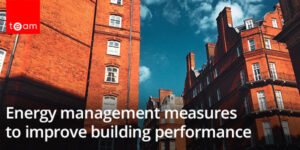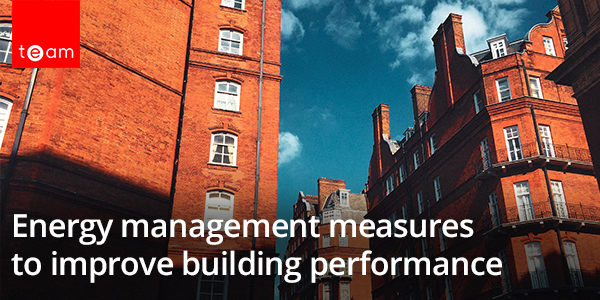Buildings old, new, large, or small, even the most sustainable and efficient ones, will need routine contribution from building users to improve their performance and operational efficiency.
This blog breaks down how you can improve the efficiency of the buildings within your organisation to complement how they are utilised, as well as how to ensure measures put in place are complied with, making the small things contribute to your wider sustainable transformation.
Update your Building User Guide
A Building User Guide (BUG) provides building occupants with a simple, quick and easy guide to the everyday functions of the building. It helps ensure a safe and healthy work environment while complimenting the efficient operation of the building to the full potential provided by the design.
From an energy management view, a BUG can provide energy efficiency and water saving measures that occupants can comply with; so make sure one is available for all responsible staff to refer to at any time, and that everyone is aware of their responsibilities.
To get the most out of your BUG, it should be reviewed annually and updated when changes to the structure or services of the building have been made.
Make sure you have the right Operation and Maintenance (O&M) manuals
Depending on your building type, you might have use of Operation and Maintenance manuals which explain the running and maintenance instructions for your buildings and equipment. These can be handy when assuming responsibility for new premises as you will have the core information you need about operations up front.
To get the most out of your O&M Manuals, check if it details operating procedures that help to reduce energy consumption. These measures can help you make efficiencies and cut costs.
Keep up the maintenance
Equipment in good condition is more efficient and less likely to break down, so keep up the maintenance. Make sure that all systems and equipment in your remit are checked regularly. Perhaps set up a maintenance rota to remind you to check the most used and high consumption equipment.
Also check that the policies and procedures in place support a pro-active approach that facilitates regular checks and assessments to mitigate system failures.
Utilise surveys and assessments
Building condition surveys, Energy Performance and DEC assessments can all provide helpful recommendations on how to improve building energy performance, including some no-cost energy saving projects. Utilise building surveys by checking:
- When the last time was you had a survey? A new survey can be especially helpful if there have been any changes to your building’s estate and function
- Is your certification and recommendation report in date? If not, get one booked in with an independent consultant who can offer impartial advice
- If any of the efficiency projects have been carried out and whether they delivered positive results? A survey can help establish the success of efficiency projects, enabling you to support future projects.
Monitor the temperature controls
The nature of your business will determine how your building is used and the ideal temperature it should operate at. Managing the temperature in accordance with the building use can reduce wastage, drive down costs, reduce carbon emissions and enhance user comfort.
Central temperature and time-based controls will help to operate at the optimal temperature. You may make a bigger impact by utilising zonal controls which are more effective where there are multiple uses and required temperatures in different areas.
Install sub-metering
If you have multiple tenants or services within the building, sub-metering enables the ability to provide accurate bills and recharge for the energy used. But the benefits of sub-metering go further. If your organisation has high energy consumption, sub-metering can help you identify areas of inefficiency, prompt action and help you save money on utility costs.
Additionally, sub-metering will help you meet any regulatory obligations, such as ESOS, get a superior understanding of the property’s energy usage, identify unusual spikes in demand, and see the impact of any operational changes and energy-saving measures.
Use your utility data
Having access to accurate and complete utility data is crucial when managing energy. The information holds to key to understanding your estate, helping you make strategic decisions, streamline budgeting, surpass carbon reduction targets, and drive down consumption usage.
To make the most of your data, check:
- That the energy consumption data collected and collated is correct. If you have a system such as Sigmait will provide estimates and fill in data gaps
- Whether the utility meters and bills are checked for anomalies regularly; doing this can provide cost recoveries
- That the out-of-hours consumption is correct as this could highlight wastage
- Whether you can perform any trend analysis to make it easy to see whether your data is in line with what is expected
- If your data is one system, assembling data for reporting will be much simpler.
Review your tariffs
A carefully selected utility tariff can make a difference to your energy costs. But, because tariffs can change and contract periods expire, which could result in defaulting to a higher rate, it is important to review the tariff regularly.
Whilst it may be time consuming to evaluate, money can be saved by securing the tariff that best suits your typical energy consumption and the size of your building. Important things to consider when reviewing your tariff include:
- Is it a fixed or variable rate?
- Is your current supplier offering the most competitive rates?
- Is a duel-fuel or single fuel contract the best value for you?
- If your organisation’s priority is sustainability, ask your supplier whether the energy you procure is green.
Take advantage of grants and incentives
There are many energy efficiency grants and incentive schemes available from the Government. The Renewable Heat Incentive (RHI), Combined Heat and Power Quality Assurance (CHPQA) Programme, and Capacity Market (CM) are among them.
If you are not already taking advantage of them, it may be time to investigate what is available and suitable for your business, how you go about applying and what the compliance commitments involve.
Review heating and cooling systems
A system that is intensively used will become less efficient as it ages and could be the source of energy wastage. Ideally, a system maintenance, clean and check should take place once a year. Check the validity of your air-conditioning TM44 certificate; an air-conditioning inspection will provide a more detailed oversight and provide a report with detailed recommendations to greatly improve the efficiency of the system.
If your system is old, it could be practical and more cost-effective in the long term to upgrade the whole system. There are many low carbon systems (biomass and heat pumps for example) that are extremely cost-effective, making the building more efficient, and benefiting your organisation’s sustainability goals.
Don’t overlook water usage
Water usage can often get overlooked when thinking about boosting efficiency for a building. From an energy management perspective, there can be savings to be made by implementing systems and procedures to reduce water usage. Dual flush water systems, low usage water appliances and fittings, and rainwater harvesting options can make an impact on how much water is used in your property.
Plus, monitoring water consumption data carefully can also help you protect your building from undetected water leaks that can not only waste large quantities of water, but can also be extremely damaging to the fabric of the property, which would be costly to repair.
Upgrade your lighting
Lighting an unused room is the most obvious source of energy wastage, which is why sensors are important in the aim to make your building more efficient. The lighting installed should be suitable for the types of work that take place in the building and different areas in a building will require different lighting requirements.
To maximise the lighting and enhance building user comfort, consider:
- Upgrading all bulbs to LED, where possible
- Whether it would be beneficial to replace the lighting in selected or all areas
- Different types of lighting controls to ensure lighting is on when needed, for example:
- Passive Infrared Sensors to detect when a room is occupied
- Solar controls will balance the light according to the amount of natural light in a room
- Timed controls to complement when your building is occupied.
Alternative energy
Switching to green energy would support your organisation’s contribution to the government’s net-zero targets. Whilst 2050 seems like a long way off, adopting renewable resources sooner will hasten your organisation’s sustainable transformation and provide operational benefits over a longer-term.
Consider whether renewable systems, such as solar, photovoltaic, heat pump (ground or air source), biomass, or wind generation would be a feasibility in the property you manage.
Optimise your glazing
The glazing in your building will have a large impact on the internal temperature and lighting. A south-facing room with large windows will feel warmer and lighter than a north-facing room, this affects how you are keeping a comfortable temperature and controlling lighting within the building.
Take into account your building type (period, modern, heavily glazed high-rise) and consider whether the current glazing specification is adequate for all areas in the building:
- How does it affect the heating and cooling systems internally in different parts of the building?
- Can the internal condition of the property be improved by installing window films?
- Would an improved system assist with areas of overheating and high solar gains control?
If you would like advice on boosting the efficiency of the buildings you look after, TEAM’s experienced energy consultants can carry out comprehensive Audits and Surveys, provide valuable insights and propose a number of recommendations to suit your business. If you would like to talk to TEAM, call on 01908 690018 or contact them today.

